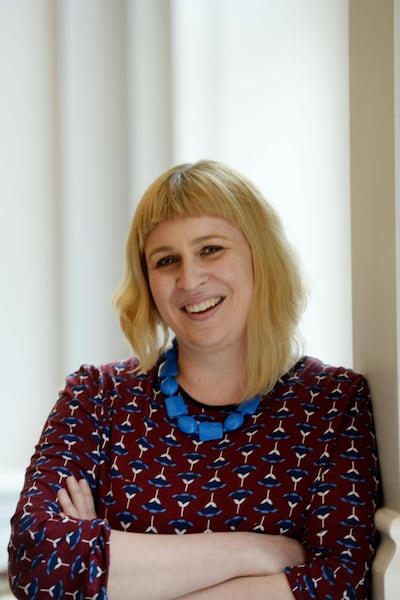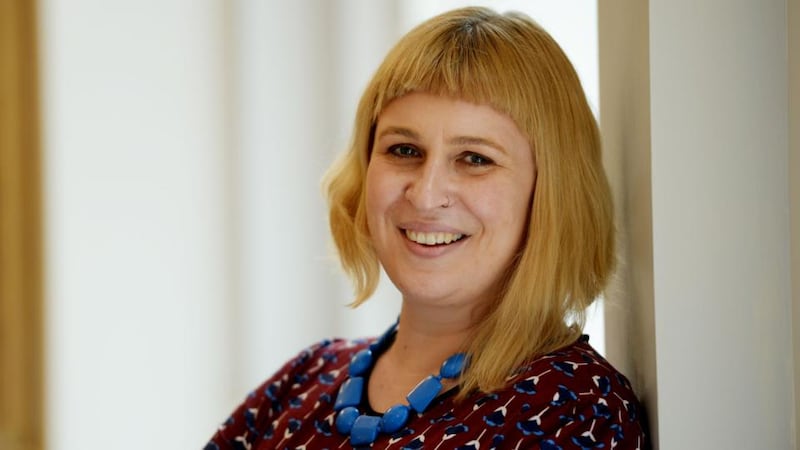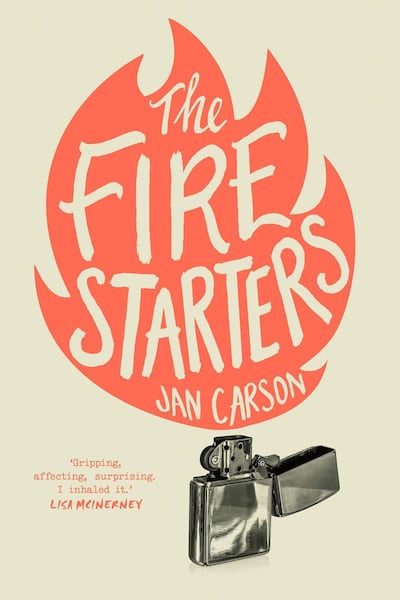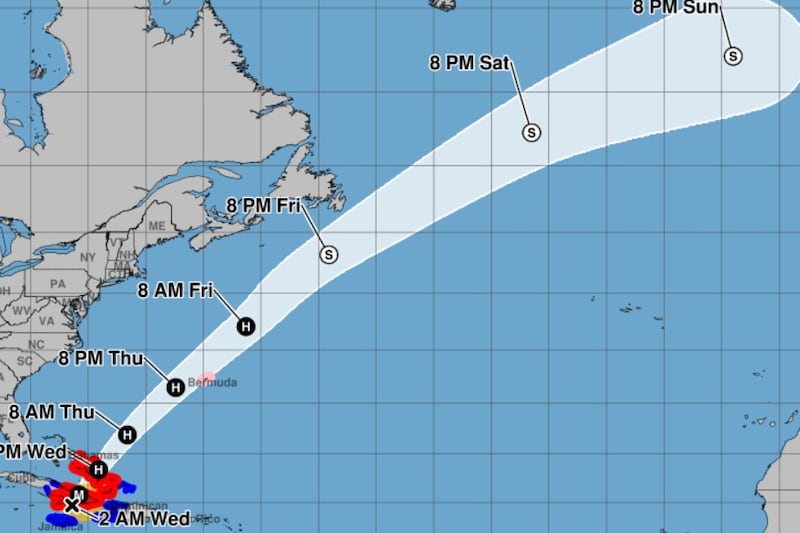A few years ago, the writer Jan Carson was in Washington DC, reading from her story, Larger Ladies, which is set in a fantastical private clinic where women are put in a coma and shaken into slimness.
“I said: ‘This is magic realism, we don’t really do all this in the North’. Then I read a description of a bonfire, which ended up being the description that’s in The Fire Starters. And somebody said, ‘Oh, more magic realism!’ And I said ‘no, no.’ But this idea went up in my head.”
Carson started looking at the symbols of loyalism with fresh eyes. “They’re these exaggerated, larger-than-life, almost magical things, like 70-foot bonfires and King Billy on a white horse and the red hand of Ulster and giant lambeg drums that are so big you can hardly lift them,” she says. “They’re not subtle images. So I started playing with those and that’s what intrigued me, that there is a line there between what’s real and believable and what someone in America who wasn’t familiar with our culture would see as absurd and fantastical.”
Set over the course of a hot, strange Belfast summer, Carson's extraordinary, wildly magical new novel The Fire Starters is the story of two fathers who are both, in very different ways, afraid of their children: Sammy, whose son Mark plots chaos from his attic bedroom and Jonathan, whose baby daughter may have inherited her mother's uncanny powers. Meanwhile Belfast is going up in flames, inspired by a mysterious YouTuber who urges his peers to circumvent the 30 foot height limits on July bonfires by lighting fires in high spots.
People wonder without all the symbols that tell me who I am, am I anybody?
In the novel, the angry people who light the tall fires are the young men who have no real memory of the Troubles. This is a segment of the population that clings closely to the old symbols. “This is a generalisation….but there was a feeling in the unionist community that post Good Friday, it was they who made most of the sacrifices and the compromises,” says Carson. At the same time, east Belfast saw mass unemployment as skilled labour declined, as did church attendance, two things which had previously forged a sense of identity. “‘[people wonder] without all the symbols that tell me who I am, am I anybody?’ And I wanted to explore that with this younger community, who maybe don’t understand the gravitas of what went on in the Troubles and how violent and awful it was. They feel undermined and a bit lost and they don’t know who they are anymore.”
The traditionally working class Protestant east Belfast is changing, Carson says. It's seen the arrival not just of young professionals but "lot of artists, both Protestant and Catholic and all sorts of diverse backgrounds, because they can afford to buy a house there, which they can't over by the university or Ormeau Road." She talks about a group of artists who have taken over a former technical college in a street of terraced houses. "I don't know of another community anywhere in Ireland that has this juxtaposition of real avant garde, eccentric strange artists working in a place where at the end of the street are all these paramilitary murals."
Magic Realism

As in much of her earlier work, Carson seamlessly weaves together the fantastical and the everyday in The Fire Starters. What is about magic realism that appeals to her? “I’ve got a really low boredom threshold,” she laughs. “I get to a certain point with realism and I just think, could we go a wee bit further here? Is there another layer? What if she flew? What if they disappeared? And so there’s a playfulness in me that likes to just push the boundaries of what I can get away with.”
The roots of her interest in the fantastic lie, she thinks, in her religious upbringing. "Whatever primary form of storytelling language that you learn is like your first language," she says. "You revert to that. So when it came to me writing the two big things were the flow of words – if you grow up on the King James Bible, the language is really beautiful. It's not just the meaning of the sentences, it's how they flow together…And the other thing is those allegories and metaphors and absurd, exaggerated images which are all through the bible stories. They come to me quite naturally because that was my first language that I learned."
The absurd and surreal, she adds, can be an effective way of exploring big issues. "We need to be able to critique and be honest about what is not right in [A]community, alongside what's good and worthy of celebration," she says. "And when you do that against a backdrop of something like loyalism, having a buffer and being able to throw in some magic [means]people don't recognise allegory as quickly as they will recognise a realist piece of text. They're not as quick to see themselves in it." Her heroes are "people like Kurt Vonnegut, Gabriel Garcia Marquez, who use absurdism and metaphor and imagery to say some really difficult things that would have been hard for them to say straightforwardly."
Identity

Carson is aware of the burden of representation that is placed on writers from Northern Ireland whose work is read internationally. Whenever she does an event outside Ireland and the audience begin to ask questions, it's never long before someone asks her about Northern Irish politics. "That was a shock to me," she says. "I had signed up to be a writer and by virtue of being Northern Irish, I would also have to talk about the politics of where I'm from. At the start I was very, very reluctant to do that but what I've realised over the last few years is that I wanted to do that. I don't want to do it because someone is forcing me to, but because I don't see my own personal experience of growing up rural Protestant represented in anything that I read…I'm not writing it because I have a point to make or because I feel the weight of responsibility. I'm writing it because this is the narrative I know best."
Her next novel is set in a rural Protestant community in the early 1990s, the world she grew up in but which she never saw reflected in literature. “Growing up as a kid I didn’t pick up any books and go ‘oh look, that’s just like what our household was like’,” she says. “And what that does to you is it passes down this message that your culture’s not examined, explored, represented, so it must not be worthy of being looked at.”
If you push me to write down what I am, I'm Northern Irish, and it's a muddy kind of self-created sense of identity
She sees herself, she says, as “an Irish writer”, but Carson has been thinking a lot about her identity recently. “There was a period post Good Friday for about 20 years where it felt like it was okay in Northern Ireland to have a multiplicity of identities,” she says. “So I could have said ‘I have a British passport and I’m probably politically British, but I feel culturally Irish. I feel part of something here. And if you push me to write down what I am, I’m Northern Irish, and it’s a muddy kind of self-created sense of identity, but [it works]. My friends and peers in the artists community in Belfast would say something similar, they’ve created a kind of mish mash of an identity that they feel comfortable with.”
Brexit, however, threatens this comfortable complexity. “The thing about a border is that a border is a line, and a line has two sides to it, and suddenly you’re on one side of it or the other,” she says. “And what Brexit and the implication of a hard border says to me is ‘pick a side’. You can’t be lots of things at once, you have to be one thing. And that terrifies me.”
Dementia
Carson has just got funding for an academic study she's working on with linguists and health professionals at Queens University on the representation of dementia in literature. In anticipation of this, she's been "furiously trying to get a couple of books ahead of myself so I could take a good chunk of time next year to focus on [the study]." In fact, the only downside of Carson's professional success as a fiction writer is the fact that she has less time for community arts projects; she formerly worked for Belfast City Council as a community outreach worker before going freelance, and her primary focus is working with older people.

Running a dementia-friendly cinema club may seem a far cry from writing fiction, but to Jan Carson, it’s all part of the same practice. “There’s a really great book that Vona Groarke wrote about frames and pictures and where the actual image ends and the frame begins,” she says. “The frame is the thing that stops the art from bleeding out into the real world. You need to have a line around it somewhere. But for me I don’t really see a frame in what I do. So much of my work with community groups bleeds into my writing and so much of my writing bleeds back into my community work.”
The Fire Starters is published by Doubleday Ireland, £12.99


















